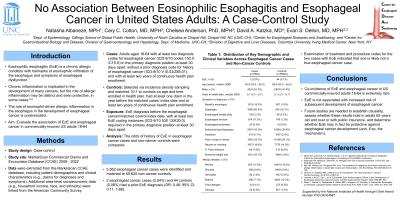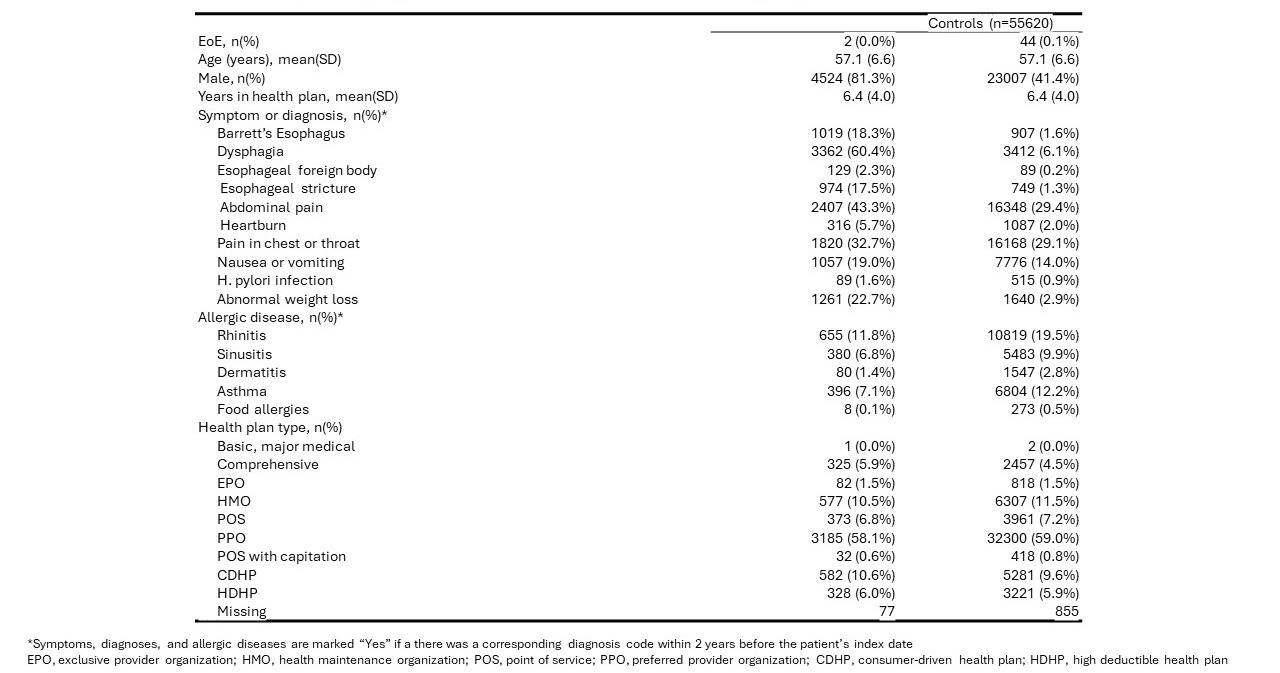Sunday Poster Session
Category: Esophagus
P0474 - No Association Between Eosinophilic Esophagitis and Esophageal Cancer in United States Adults: A Case Control Study
Sunday, October 27, 2024
3:30 PM - 7:00 PM ET
Location: Exhibit Hall E

- NA
Natasha Albaneze, MPH
University of North Carolina at Chapel Hill
Chapel Hill, NC
Presenting Author(s)
Natasha Albaneze, MPH1, Cary C. Cotton, MD, MPH2, Chelsea Anderson, PhD, MPH3, David A.. Katzka, MD4, Evan S.. Dellon, MD, MPH, FACG2
1University of North Carolina at Chapel Hill, Chapel Hill, NC; 2University of North Carolina at Chapel Hill School of Medicine, Chapel Hill, NC; 3University of North Carolina, Chapel Hill, NC; 4New York-Presbyterian/Columbia University Irving Medical Center, New York, NY
Introduction: Despite the known role of inflammation in the development of numerous cancers, few studies have examined whether chronic inflammation due to eosinophilic esophagitis (EoE) increases the risk of esophageal cancer (EC). We aimed to assess whether adults with EoE were more likely to have a subsequent EC diagnosis.
Methods: This case-control study used data from the IBM MarketScan Commercial Claims and Encounters database. Cases were adults with an EC diagnosis (≥2 instances of ICD9/10 codes 150.X /C15.X) between 2011 and 2022, who were 18-64 years old at the time of diagnosis and had no history of previous EC (no instance of V10.03/Z85.01 before index date). Incidence density sampling was used to identify controls, who were matched 10:1 on age and time in health plan, and who had evidence of at least one healthcare contact in the year before their corresponding case’s EC index date. All cases and controls had at least two years of continuous healthcare coverage before the index date. As with EC status, EoE status was determined using ICD-9/10 codes (≥2 instances of 530.13/K20.0). We used conditional logistic regression modeling to estimate the odds ratio and 95% confidence interval for the association between EoE and EC.
Results: We identified 5,562 eligible esophageal cancer cases and matched 55,620 controls for inclusion. The mean age of cases and controls was 57.1 years and the mean number of years in the health plan was 6.4 (Table). The proportions of male cases and controls were 81.3% and 41.4%, respectively. History of EoE was rare in both cases and controls, but it was less common in esophageal cancer. Only 2 cases (0.04%) and 44 controls (0.08%) had evidence of an EoE diagnosis (OR: 0.46; 95% CI: 0.11, 1.88). After adjusting for age, sex, history of H. pylori infection, time in health plan, and type of health plan, the odds of EoE was not elevated in EC cases compared to controls (aOR: 0.36; 95% CI: 0.09, 1.51).
Discussion: Co-incidence of EoE and EC is rare and EoE is not associated with development of EC in privately-insured adults under 65 years old. Due to limitations in population generalizability and potential for residual confounding, additional studies are needed to confirm these findings and evaluate whether they hold in older adults or over a longer follow-up period, and whether EoE might be protective of EC.

Disclosures:
Natasha Albaneze, MPH1, Cary C. Cotton, MD, MPH2, Chelsea Anderson, PhD, MPH3, David A.. Katzka, MD4, Evan S.. Dellon, MD, MPH, FACG2. P0474 - No Association Between Eosinophilic Esophagitis and Esophageal Cancer in United States Adults: A Case Control Study, ACG 2024 Annual Scientific Meeting Abstracts. Philadelphia, PA: American College of Gastroenterology.
1University of North Carolina at Chapel Hill, Chapel Hill, NC; 2University of North Carolina at Chapel Hill School of Medicine, Chapel Hill, NC; 3University of North Carolina, Chapel Hill, NC; 4New York-Presbyterian/Columbia University Irving Medical Center, New York, NY
Introduction: Despite the known role of inflammation in the development of numerous cancers, few studies have examined whether chronic inflammation due to eosinophilic esophagitis (EoE) increases the risk of esophageal cancer (EC). We aimed to assess whether adults with EoE were more likely to have a subsequent EC diagnosis.
Methods: This case-control study used data from the IBM MarketScan Commercial Claims and Encounters database. Cases were adults with an EC diagnosis (≥2 instances of ICD9/10 codes 150.X /C15.X) between 2011 and 2022, who were 18-64 years old at the time of diagnosis and had no history of previous EC (no instance of V10.03/Z85.01 before index date). Incidence density sampling was used to identify controls, who were matched 10:1 on age and time in health plan, and who had evidence of at least one healthcare contact in the year before their corresponding case’s EC index date. All cases and controls had at least two years of continuous healthcare coverage before the index date. As with EC status, EoE status was determined using ICD-9/10 codes (≥2 instances of 530.13/K20.0). We used conditional logistic regression modeling to estimate the odds ratio and 95% confidence interval for the association between EoE and EC.
Results: We identified 5,562 eligible esophageal cancer cases and matched 55,620 controls for inclusion. The mean age of cases and controls was 57.1 years and the mean number of years in the health plan was 6.4 (Table). The proportions of male cases and controls were 81.3% and 41.4%, respectively. History of EoE was rare in both cases and controls, but it was less common in esophageal cancer. Only 2 cases (0.04%) and 44 controls (0.08%) had evidence of an EoE diagnosis (OR: 0.46; 95% CI: 0.11, 1.88). After adjusting for age, sex, history of H. pylori infection, time in health plan, and type of health plan, the odds of EoE was not elevated in EC cases compared to controls (aOR: 0.36; 95% CI: 0.09, 1.51).
Discussion: Co-incidence of EoE and EC is rare and EoE is not associated with development of EC in privately-insured adults under 65 years old. Due to limitations in population generalizability and potential for residual confounding, additional studies are needed to confirm these findings and evaluate whether they hold in older adults or over a longer follow-up period, and whether EoE might be protective of EC.

Figure: Figure
Disclosures:
Natasha Albaneze indicated no relevant financial relationships.
Cary Cotton: Pentax – Grant/Research Support.
Chelsea Anderson indicated no relevant financial relationships.
David Katzka: Receptos/Celgene/Bristol Myers Squibb – Consultant. Shire, a Takeda company – Received research funding. Takeda Pharmaceuticals USA, Inc. – The study and medical writing support were funded by Takeda Pharmaceuticals USA, Inc..
Evan Dellon: Abbott – Consultant. AbbVie – Consultant. Adare/Ellodi – Consultant, Grant/Research Support. Aimmune – Consultant. Akesobio – Consultant. Alfasigma – Consultant. ALK – Consultant. Allakos – Consultant, Grant/Research Support. Amgen – Consultant. Aqilion – Consultant, Grant/Research Support. Arena/Pfizer – Consultant, Grant/Research Support. Aslan – Consultant. AstraZeneca – Consultant, Grant/Research Support. Avir – Consultant. Biorasi – Consultant. Calypso – Consultant. Celgene/Receptos/BMS – Consultant, Grant/Research Support. Celldex – Consultant. Dr. Falk Pharma – Consultant. Eli Lilly – Consultant. EsoCap – Consultant. Eupraxia – Consultant, Grant/Research Support. Ferring – Consultant, Grant/Research Support. GlaxoSmithKline – Consultant, Grant/Research Support. Gossamer Bio – Consultant. Holoclara – Consultant. Holoclara – Grant/Research Support. Invea – Consultant. Invea – Grant/Research Support. Knightpoint – Consultant. Landos – Consultant. LucidDx – Consultant. Meritage – Grant/Research Support. Miraca – Grant/Research Support. Morphic – Consultant. Nexstone Immunology/Uniquity – Consultant. Nutricia – Consultant, Grant/Research Support. Parexel/Calyx – Consultant. Phathom – Consultant. Regeneron Pharmaceuticals Inc. – Consultant, Grant/Research Support. Revolo – Consultant, Grant/Research Support. Robarts/Alimentiv – Consultant. Salix – Consultant. Sanofi – Consultant. Shire/Takeda – Consultant, Grant/Research Support. Target RWE – Consultant. Upstream Bio – Consultant.
Natasha Albaneze, MPH1, Cary C. Cotton, MD, MPH2, Chelsea Anderson, PhD, MPH3, David A.. Katzka, MD4, Evan S.. Dellon, MD, MPH, FACG2. P0474 - No Association Between Eosinophilic Esophagitis and Esophageal Cancer in United States Adults: A Case Control Study, ACG 2024 Annual Scientific Meeting Abstracts. Philadelphia, PA: American College of Gastroenterology.
